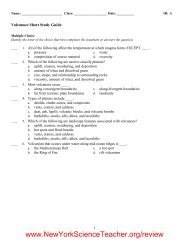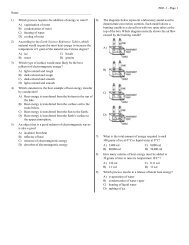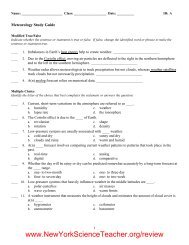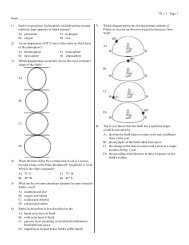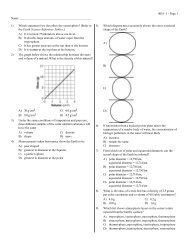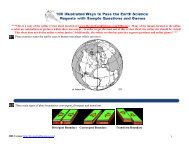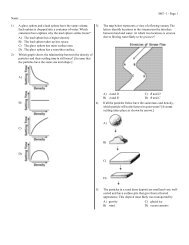Physical Setting/Earth Science Core Curriculum - p-12
Physical Setting/Earth Science Core Curriculum - p-12
Physical Setting/Earth Science Core Curriculum - p-12
You also want an ePaper? Increase the reach of your titles
YUMPU automatically turns print PDFs into web optimized ePapers that Google loves.
<strong>Physical</strong> <strong>Setting</strong>/<strong>Earth</strong> <strong>Science</strong><strong>Core</strong> <strong>Curriculum</strong>THE UNIVERSITY OF THE STATE OF NEW YORKTHE STATE EDUCATION DEPARTMENThttp://www.nysed.gov
THE UNIVERSITY OF THE STATE OF NEW YORKRegents of The UniversityCARL T. HAYDEN, Chancellor, A.B., J.D. ......................................................................ElmiraDIANE O’NEILL MCGIVERN, Vice Chancellor, B.S.N., M.A., Ph.D. ............................BaysideJ. EDWARD MEYER, B.A., LL.B. ....................................................................................ChappaquaADELAIDE L. SANFORD, B.A., M.A., P.D. ......................................................................HollisSAUL B. COHEN, B.A., M.A., Ph.D. ...............................................................................New RochelleJAMES C. DAWSON, A.A., B.A., M.S., Ph.D. ..................................................................PeruROBERT M. BENNETT, B.A., M.S. ..................................................................................TonawandaROBERT M. JOHNSON, B.S., J.D. ...................................................................................Lloyd HarborANTHONY S. BOTTAR, B.A., J.D. ...................................................................................SyracuseMERRYL H. TISCH, B.A., M.A. ......................................................................................New YorkHAROLD O. LEVY, B.S., M.A. (Oxon.), J.D. ..................................................................New YorkENA L. FARLEY, B.A., M.A., Ph.D. ................................................................................BrockportGERALDINE D. CHAPEY, B.A., M.A., Ed.D. ...................................................................Belle HarborRICARDO E. OQUENDO, B.A., J.D. .................................................................................BronxELEANOR P. BARTLETT, B.A., M.A. ...............................................................................AlbanyARNOLD B. GARDNER, B.A., LL.B..................................................................................BuffaloPresident of The University and Commissioner of EducationRICHARD P. MILLSChief Operating OfficerRICHARD H. CATEDeputy Commissioner for Elementary, Middle, Secondary, and ContinuingEducationJAMES A. KADAMUSAssistant Commissioner for <strong>Curriculum</strong>, Instruction, and AssessmentROSEANNE DEFABIOThe State Education Department does not discriminate on the basis of age, color, religion, creed, disability,marital status, veteran status, national origin, race, gender, genetic predisposition or carrier status,or sexual orientation in its educational programs, services, and activities. Portions of this publicationcan be made available in a variety of formats, including braille, large print or audio tape, uponrequest. Inquiries concerning this policy of nondiscrimination should be directed to the Department’sOffice for Diversity, Ethics, and Access, Room 152, Education Building, Albany, NY <strong>12</strong>234.
CONTENTSAcknowledgments . . . . . . . . . . . . . . . . . . . . . . . . . . . . . . .iv<strong>Core</strong> <strong>Curriculum</strong> . . . . . . . . . . . . . . . . . . . . . . . . . . . . . . . .1Preface . . . . . . . . . . . . . . . . . . . . . . . . . . . . . . . . . . . .3Process Skills Based on Standards 1, 2, 6, and 7 . . .4Standard 4 . . . . . . . . . . . . . . . . . . . . . . . . . . . . . . . . .8Appendices . . . . . . . . . . . . . . . . . . . . . . . . . . . . . . . . . . .17<strong>Earth</strong> <strong>Science</strong>iii
ACKNOWLEDGMENTSThe State Education Department acknowledges the assistance of teachers and school administrators from acrossNew York State and the <strong>Earth</strong> <strong>Science</strong> Mentor Network. In particular, the State Education Department would like tothank:John BartschJames R. EbertKathleen ChampneyDennis ConklinEdward DeneckeDennis DeSainLois GundrumFran HessSusan HoffmireAndrea HyattThomas McGuireDavid MillsGlenn OlfLen SharpBernadette TomaselliBrian VorwaldMarion Gaita ZachowskiAmsterdam High SchoolSUC OneontaColton, NYColumbia High SchoolMultidisciplinary Resource Center, Whitestone, NYAverill Park High SchoolWatervliet Junior-Senior High SchoolCooperstown High SchoolVictor High SchoolRush-Henrietta High SchoolBriarcliff Middle/High SchoolHolland Central High SchoolColumbia High SchoolLiverpool High SchoolLancaster High SchoolSayville High SchoolOffice of Superintendent of Manhattan High SchoolsThe <strong>Physical</strong> <strong>Setting</strong>/<strong>Earth</strong> <strong>Science</strong> <strong>Core</strong> <strong>Curriculum</strong> was reviewed by many teachers and administrators across theState including <strong>Earth</strong> <strong>Science</strong> Mentors. The State Education Department thanks those individuals who providedfeedback both formally and informally.In addition, the following individuals responded to a joint request by the <strong>Science</strong> Teachers Association of New YorkState and the State Education Department to review the document from their perspectives as scientists, science professors,and/or science education professors. Thanks to Brian Vorwald for organizing this effort.Nancy AllenLloyd BarrowEugene ChiappettaGerald KrockoverDon LindseyVictor MayerBarbara SchulzMichael J. SmithDavid WilliamsUniversity of Texas, Austin, TXUniversity of Missouri, Columbia, MOUniversity of Houston, Houston, TXPurdue University, W. Lafayette, INState University of New York, Stony Brook, NYOhio State University, Columbus, OHBard School, Seattle, WAAmerican Geological Institute, Alexandria, VACamden, DEThe project manager for the development of the <strong>Physical</strong> <strong>Setting</strong>/<strong>Earth</strong> <strong>Science</strong> <strong>Core</strong> <strong>Curriculum</strong> was Elise Russo,Associate in <strong>Science</strong> Education, with content and assessment support provided by Sharon Miller, Associate inEducational Testing. Diana K. Harding, Associate in <strong>Science</strong> Education, provided additional support. Specialthanks go to Jan Christman for technical expertise and to John Bartsch, Amsterdam High School, for preliminarydrafts of the document.iv<strong>Earth</strong> <strong>Science</strong>
<strong>Physical</strong> <strong>Setting</strong>/<strong>Earth</strong> <strong>Science</strong><strong>Core</strong> <strong>Curriculum</strong>
2 <strong>Earth</strong> <strong>Science</strong>
PREFACEThis <strong>Physical</strong> <strong>Setting</strong>/<strong>Earth</strong> <strong>Science</strong> <strong>Core</strong> <strong>Curriculum</strong> hasbeen written to assist teachers and supervisors as theyprepare curriculum, instruction, and assessment for the<strong>Earth</strong> <strong>Science</strong> content and process skills of the NewYork State Learning Standards for Mathematics, <strong>Science</strong>,and Technology. This <strong>Core</strong> <strong>Curriculum</strong> should be seen aspart of a continuum that elaborates the science contentof Standard 4. The learning standards document identifiesKey Ideas and Performance Indicators. This documentis essential for interpretation by the teacher inimplementing the core understandings. Key Ideas arebroad, unifying, general statements of what studentsneed to know. The Performance Indicators for each KeyIdea are statements of what students should be able todo to provide evidence that they understand the KeyIdea. As part of this continuum, this <strong>Core</strong> <strong>Curriculum</strong>presents Major Understandings that give more specificdetail to the concepts underlying each PerformanceIndicator.This <strong>Core</strong> <strong>Curriculum</strong> is not a syllabus. It addresses thecontent and process skills as applied to the rigor andrelevancy to be assessed by the Regents examination in<strong>Physical</strong> <strong>Setting</strong>/<strong>Earth</strong> <strong>Science</strong>. Focus will also be onapplication skills related to real-world situations. The<strong>Core</strong> <strong>Curriculum</strong> has been prepared with the assumptionthat the content as outlined in the LearningStandards for Mathematics, <strong>Science</strong>, and Technology at theelementary and intermediate levels has been taughtpreviously. This is a guide for the preparation of commencement-levelcurriculum, instruction, and assessment,the final stage in a K-<strong>12</strong> continuum of scienceeducation. Teachers should recognize that what isfound in this document is the minimum of the contentto be taught. Teachers are expected to provide for horizontaland vertical enrichment. Rather, the focus onconceptual understanding in the guide is consistentwith the approaches recommended in the National<strong>Science</strong> Education Standards and Benchmarks of <strong>Science</strong>Literacy: Project 2061.informed decision making. Future assessments will teststudentsÕ ability to explain, analyze, and interpret <strong>Earth</strong>science processes and phenomena, and generate scienceinquiry. The general nature of these statements willencourage the teaching of science for this understanding,instead of for memorization. The MajorUnderstandings in this guide will also allow teachersmore flexibility, making possible richer creativity ininstruction and greater variation in assessment.The order of presentation and numbering of all statementsin this guide are not meant to indicate any recommendedsequence of instruction. Ideas have notbeen prioritized, nor have they been organized to indicateteaching time allotments or test weighting.Teachers are encouraged to find and elaborate for studentsthe conceptual cross-linkages that interconnectmany of the Key Ideas to each other and to other mathematics,science, and technology learning standards.Material found on the <strong>Earth</strong> <strong>Science</strong> Reference Tablesshould also be considered part of the <strong>Core</strong> <strong>Curriculum</strong>.Laboratory Requirements: Critical to understandingscience concepts is the use of scientific inquiry todevelop explanations of natural phenomena. Therefore,as a prerequisite for admission to the Regents examinationin <strong>Physical</strong> <strong>Setting</strong>/<strong>Earth</strong> <strong>Science</strong>, students musthave successfully completed <strong>12</strong>00 minutes of laboratoryexperience with satisfactory written reports foreach laboratory investigation.It is expected that laboratory experiences will providethe opportunity for students to develop the scientificinquiry techniques in Standard 1, Standard 2, and theinterconnectedness of content and skills, and theproblem-solving approaches in Standards 6 and 7.It is essential that instruction focus on student understandingand demonstration of important relationships,processes, mechanisms, and applications of concepts.Students, in attaining scientific literacy, will be able todemonstrate these explanations, in their own words,exhibiting creative problem solving, reasoning, and<strong>Earth</strong> <strong>Science</strong> 3
PROCESS SKILLSBASED ON STANDARDS 1, 2, 6, AND 7<strong>Science</strong> process skills should be based on a series of discoveries. Students learn most effectively when they have a central role inthe discovery process. To that end, Standards 1, 2, 6, and 7 incorporate in the <strong>Physical</strong> <strong>Setting</strong>/<strong>Earth</strong> <strong>Science</strong> <strong>Core</strong><strong>Curriculum</strong> a student-centered, problem-solving approach to <strong>Earth</strong> <strong>Science</strong>. The following is a sample of <strong>Earth</strong> <strong>Science</strong> processskills. This list is not intended to be an all-inclusive list of the content or skills, but rather a sample of the types of activitiesthat teachers are expected to incorporate into their curriculum. It should be a goal of the instructor to encourage science processskills that will provide students with background and curiosity to investigate important issues in the world around them.STANDARD 1—Analysis, Inquiry, and DesignStudents will use mathematical analysis, scientific inquiry, and engineering design, as appropriate, to pose questions,seek answers, and develop solutions.STANDARD 1Analysis, Inquiry,and DesignMATHEMATICALANALYSIS:Key Idea 1:Abstraction and symbolic representation are used to communicate mathematically.For example:¥ use eccentricity, rate, gradient, standard error of measurement, and density in contextKey Idea 2:Deductive and inductive reasoning are used to reach mathematical conclusions.For example:¥ determine the relationships among: velocity, slope, sediment size, channel shape, andvolume of a stream¥ understand the relationships among: the planetsÕ distance from the Sun, gravitationalforce, period of revolution, and speed of revolutionKey Idea 3:Critical thinking skills are used in the solution of mathematical problems.For example:¥ in a field, use isolines to determine a source of pollutionSTANDARD 1Analysis, Inquiry,and DesignSCIENTIFICINQUIRY:Key Idea 1:The central purpose of scientific inquiry is to develop explanations of natural phenomenain a continuing, creative process.For example:¥ show how our observation of celestial motions supports the idea of stars movingaround a stationary <strong>Earth</strong> (the geocentric model), but further investigation has ledscientists to understand that most of these changes are a result of <strong>Earth</strong>Õs motionaround the Sun (the heliocentric model)Key Idea 2:Beyond the use of reasoning and consensus, scientific inquiry involves the testing ofproposed explanations involving the use of conventional techniques and proceduresand usually requiring considerable ingenuity.For example:¥ test sediment properties and the rate of depositionKey Idea 3:The observations made while testing proposed explanations, when analyzed using conventionaland invented methods, provide new insights into phenomena.For example:¥ determine the changing length of a shadow based on the motion of the Sun4 <strong>Earth</strong> <strong>Science</strong>
STANDARD 1Analysis, Inquiry,and DesignENGINEERINGDESIGN:Key Idea 1:Engineering design is an iterative process involving modeling and optimization (findingthe best solution within given constraints); this process is used to develop technologicalsolutions to problems within given constraints.For example:¥ after experimenting with conduction of heat (using calorimeters and aluminum bars),make recommendations to create a more efficient system of heat transfer¥ determine patterns of topography and drainage around your school and designsolutions to effectively deal with runoffSTANDARD 2Students will access, generate, process, and transfer information, using appropriate technologies.STANDARD 2INFORMATIONSYSTEMS:Key Idea 1:Information technology is used to retrieve, process, and communicate information as atool to enhance learning.For example:¥ analyze weather maps to predict future weather events¥ use library or electronic references to obtain information to support a laboratoryconclusionKey Idea 2:Knowledge of the impacts and limitations of information systems is essential to its effectiveand ethical use.For example:¥ obtain printed or electronic materials which exemplify miscommunication and/ormisconceptions of current commonly accepted scientific knowledgeKey Idea 3:Information technology can have positive and negative impacts on society, dependingupon how it is used.For example:¥ discuss how early warning systems can protect society and the environment fromnatural disasters such as hurricanes, tornadoes, earthquakes, tsunamis, floods, andvolcanoesSTANDARD 6—Interconnectedness: Common ThemesStudents will understand the relationships and common themes that connect mathematics, science, and technologyand apply the themes to these and other areas of learning.STANDARD 6Interconnectedness:CommonThemesSYSTEMSTHINKING:Key Idea 1:Through systems thinking, people can recognize the commonalities that exist among allsystems and how parts of a system interrelate and combine to perform specificfunctions.For example:¥ analyze a depositional-erosional system of a stream<strong>Earth</strong> <strong>Science</strong> 5
STANDARD 6Interconnectedness:CommonThemesMODELS:Key Idea 2:Models are simplified representations of objects, structures, or systems used in analysis,explanation, interpretation, or design.For example:¥ draw a simple contour map of a model landform¥ design a 3-D landscape model from a contour map¥ construct and interpret a profile based on an isoline map¥ use flowcharts to identify rocks and mineralsSTANDARD 6Interconnectedness:CommonThemesMAGNITUDE ANDSCALE:Key Idea 3:The grouping of magnitudes of size, time, frequency, and pressures or other units ofmeasurement into a series of relative order provides a useful way to deal with theimmense range and the changes in scale that affect the behavior and design of systems.For example:¥ develop a scale model to represent planet size and/or distance¥ develop a scale model of units of geologic time¥ use topographical maps to determine distances and elevationsSTANDARD 6Interconnectedness:CommonThemesEQUILIBRIUM ANDSTABILITY:Key Idea 4:Equilibrium is a state of stability due either to a lack of change (static equilibrium) or abalance between opposing forces (dynamic equilibrium).For example:¥ analyze the interrelationship between gravity and inertia and its effects on the orbitof planets or satellitesSTANDARD 6Interconnectedness:CommonThemesPATTERNS OFCHANGE:Key Idea 5:Identifying patterns of change is necessary for making predictions about futurebehavior and conditions.For example:¥ graph and interpret the nature of cyclic change such as sunspots, tides, andatmospheric carbon dioxide¥ based on present data of plate movement, determine past and future positions of landmasses¥ using given weather data, identify the interface between air masses, such as coldfronts, warm fronts, and stationary frontsSTANDARD 6Interconnectedness:CommonThemesOPTIMIZATION:Key Idea 6:In order to arrive at the best solution that meets criteria within constraints, it is oftennecessary to make trade-offs.For example:¥ debate the effect of human activities as they relate to quality of life on <strong>Earth</strong> systems(global warming, land use, preservation of natural resources, pollution)6 <strong>Earth</strong> <strong>Science</strong>
STANDARD 7—Interdisciplinary Problem SolvingStudents will apply the knowledge and thinking skills of mathematics, science, and technology to address real-lifeproblems and make informed decisions.STANDARD 7InterdisciplinaryProblemSolvingCONNECTIONS:Key Idea 1:The knowledge and skills of mathematics, science, and technology are used together tomake informed decisions and solve problems, especially those relating to issues of science/technology/society,consumer decision making, design, and inquiry into phenomena.For example:¥ analyze the issues related to local energy needs and develop a viable energygeneration plan for the community¥ investigate two similar fossils to determine if they represent a developmental changeover time¥ investigate the political, economic, and environmental impact of global distributionand use of mineral resources and fossil fuels¥ consider environmental and social implications of various solutions to an environmental<strong>Earth</strong> resources problemSTANDARD 7InterdisciplinaryProblemSolvingSTRATEGIES:Key Idea 2:Solving interdisciplinary problems involves a variety of skills and strategies, includingeffective work habits; gathering and processing information; generating and analyzingideas; realizing ideas; making connections among the common themes of mathematics,science, and technology; and presenting results.For example:¥ collect, collate, and process data concerning potential natural disasters (tornadoes,thunderstorms, blizzards, earthquakes, tsunamis, floods, volcanic eruptions, asteroidimpacts, etc.) in an area and develop an emergency action plan¥ using a topographic map, determine the safest and most efficient route for rescuepurposes<strong>Earth</strong> <strong>Science</strong> 7
STANDARD 4Students will understand and apply scientific concepts, principles, and theories pertaining to the physicalsetting and living environment and recognize the historical development of ideas in science.Key Idea 1:The <strong>Earth</strong> and celestial phenomena can be described by principles of relative motion and perspective.People have observed the stars for thousands of years, using them to find direction, note the passage of time, and toexpress their values and traditions. As our technology has progressed, so has understanding of celestial objects andevents.Theories of the universe have developed over many centuries. Although to a casual observer celestial bodiesappeared to orbit a stationary <strong>Earth</strong>, scientific discoveries led us to the understanding that <strong>Earth</strong> is one planet thatorbits the Sun, a typical star in a vast and ancient universe. We now infer an origin and an age and evolution of theuniverse, as we speculate about its future.As we look at <strong>Earth</strong>, we find clues to its origin and how it has changed through nearly five billion years, as well asthe evolution of life on <strong>Earth</strong>.PERFORMANCEINDICATOR 1.1Explain complex phenomena, such as tides, variations in day length, solar insolation,apparent motion of the planets, and annual traverse of the constellations.Major Understandings:1.1a Most objects in the solar system are in regular and predictable motion.¥ These motions explain such phenomena as the day, the year, seasons, phases of themoon, eclipses, and tides.¥ Gravity influences the motions of celestial objects. The force of gravity between twoobjects in the universe depends on their masses and the distance between them.1.1b Nine planets move around the Sun in nearly circular orbits.¥ The orbit of each planet is an ellipse with the Sun located at one of the foci.¥ <strong>Earth</strong> is orbited by one moon and many artificial satellites.1.1c <strong>Earth</strong>Õs coordinate system of latitude and longitude, with the equator and primemeridian as reference lines, is based upon <strong>Earth</strong>Õs rotation and our observation of theSun and stars.1.1d <strong>Earth</strong> rotates on an imaginary axis at a rate of 15 degrees per hour. To people on<strong>Earth</strong>, this turning of the planet makes it seem as though the Sun, the moon, and thestars are moving around <strong>Earth</strong> once a day. Rotation provides a basis for our system oflocal time; meridians of longitude are the basis for time zones.1.1e The Foucault pendulum and the Coriolis effect provide evidence of <strong>Earth</strong>Õsrotation.1.1f <strong>Earth</strong>Õs changing position with regard to the Sun and the moon has noticeableeffects.¥ <strong>Earth</strong> revolves around the Sun with its rotational axis tilted at 23.5 degrees to a lineperpendicular to the plane of its orbit, with the North Pole aligned with Polaris.8 <strong>Earth</strong> <strong>Science</strong>
PERFORMANCEINDICATOR 1.1continued¥ During <strong>Earth</strong>Õs one-year period of revolution, the tilt of its axis results in changes inthe angle of incidence of the SunÕs rays at a given latitude; these changes cause variationin the heating of the surface. This produces seasonal variation in weather.1.1g Seasonal changes in the apparent positions of constellations provide evidence of<strong>Earth</strong>Õs revolution.1.1h The SunÕs apparent path through the sky varies with latitude and season.1.1i Approximately 70 percent of <strong>Earth</strong>Õs surface is covered by a relatively thin layer ofwater, which responds to the gravitational attraction of the moon and the Sun with adaily cycle of high and low tides.PERFORMANCEINDICATOR 1.2Describe current theories about the origin of the universe and solar system.Major Understandings:1.2a The universe is vast and estimated to be over ten billion years old. The current theoryis that the universe was created from an explosion called the Big Bang. Evidence forthis theory includes:¥ cosmic background radiation¥ a red-shift (the Doppler effect) in the light from very distant galaxies.1.2b Stars form when gravity causes clouds of molecules to contract until nuclear fusionof light elements into heavier ones occurs. Fusion releases great amounts of energy overmillions of years.¥ The stars differ from each other in size, temperature, and age.¥ Our Sun is a medium-sized star within a spiral galaxy of stars known as the MilkyWay. Our galaxy contains billions of stars, and the universe contains billions of suchgalaxies.1.2c Our solar system formed about five billion years ago from a giant cloud of gas anddebris. Gravity caused <strong>Earth</strong> and the other planets to become layered according todensity differences in their materials.¥ The characteristics of the planets of the solar system are affected by each planetÕslocation in relationship to the Sun.¥ The terrestrial planets are small, rocky, and dense. The Jovian planets are large,gaseous, and of low density.1.2d Asteroids, comets, and meteors are components of our solar system.¥ Impact events have been correlated with mass extinction and global climatic change.¥ Impact craters can be identified in <strong>Earth</strong>Õs crust.1.2e <strong>Earth</strong>Õs early atmosphere formed as a result of the outgassing of water vapor,carbon dioxide, nitrogen, and lesser amounts of other gases from its interior.1.2f <strong>Earth</strong>Õs oceans formed as a result of precipitation over millions of years. The presenceof an early ocean is indicated by sedimentary rocks of marine origin, dating backabout four billion years.<strong>Earth</strong> <strong>Science</strong> 9
PERFORMANCEINDICATOR 1.2continued1.2g <strong>Earth</strong> has continuously been recycling water since the outgassing of water early inits history. This constant recirculation of water at and near <strong>Earth</strong>Õs surface is describedby the hydrologic (water) cycle.¥ Water is returned from the atmosphere to <strong>Earth</strong>Õs surface by precipitation. Waterreturns to the atmosphere by evaporation or transpiration from plants. A portion ofthe precipitation becomes runoff over the land or infiltrates into the ground tobecome stored in the soil or groundwater below the water table. Soil capillarityinfluences these processes.¥ The amount of precipitation that seeps into the ground or runs off is influenced byclimate, slope of the land, soil, rock type, vegetation, land use, and degree ofsaturation.¥ Porosity, permeability, and water retention affect runoff and infiltration.1.2h The evolution of life caused dramatic changes in the composition of <strong>Earth</strong>Õsatmosphere. Free oxygen did not form in the atmosphere until oxygen-producingorganisms evolved.1.2i The pattern of evolution of life-forms on <strong>Earth</strong> is at least partially preserved in therock record.¥ Fossil evidence indicates that a wide variety of life-forms has existed in the past andthat most of these forms have become extinct.¥ Human existence has been very brief compared to the expanse of geologic time.1.2j Geologic history can be reconstructed by observing sequences of rock types andfossils to correlate bedrock at various locations.¥ The characteristics of rocks indicate the processes by which they formed and the environmentsin which these processes took place.¥ Fossils preserved in rocks provide information about past environmentalconditions.¥ Geologists have divided <strong>Earth</strong> history into time units based upon the fossilrecord.¥ Age relationships among bodies of rocks can be determined using principles of originalhorizontality, superposition, inclusions, cross-cutting relationships, contact metamorphism,and unconformities. The presence of volcanic ash layers, index fossils, andmeteoritic debris can provide additional information.¥ The regular rate of nuclear decay (half-life time period) of radioactive isotopes allowsgeologists to determine the absolute age of materials found in some rocks.10 <strong>Earth</strong> <strong>Science</strong>
Key Idea 2:Many of the phenomena that we observe on <strong>Earth</strong> involve interactions among components of air, water, andland.<strong>Earth</strong> may be considered a huge machine driven by two engines, one internal and one external. These heat enginesconvert heat energy into mechanical energy.<strong>Earth</strong>Õs external heat engine is powered primarily by solar energy and influenced by gravity. Nearly all the energyfor circulating the atmosphere and oceans is supplied by the Sun. As insolation strikes the atmosphere, a small percentageis directly absorbed, especially by gases such as ozone, carbon dioxide, and water vapor. Clouds and <strong>Earth</strong>Õssurface reflect some energy back to space, and <strong>Earth</strong>Õs surface absorbs some energy. Energy is transferred between<strong>Earth</strong>Õs surface and the atmosphere by radiation, conduction, evaporation, and convection. Temperature variationswithin the atmosphere cause differences in density that cause atmospheric circulation, which is affected by <strong>Earth</strong>Õsrotation. The interaction of these processes results in the complex atmospheric occurrence known as weather.Average temperatures on <strong>Earth</strong> are the result of the total amount of insolation absorbed by <strong>Earth</strong>Õs surface and itsatmosphere and the amount of long-wave energy radiated back into space. However, throughout geologic time, iceages occurred in the middle latitudes. In addition, average temperatures may have been significantly warmer attimes in the geologic past. This suggests that <strong>Earth</strong> had climate changes that were most likely associated with longperiods of imbalances of its heat budget.<strong>Earth</strong>Õs internal heat engine is powered by heat from the decay of radioactive materials and residual heat from<strong>Earth</strong>Õs formation. Differences in density resulting from heat flow within <strong>Earth</strong>Õs interior caused the changesexplained by the theory of plate tectonics: movement of the lithospheric plates; earthquakes; volcanoes; and thedeformation and metamorphism of rocks during the formation of young mountains.Precipitation resulting from the external heat engineÕs weather systems supplies moisture to <strong>Earth</strong>Õs surface thatcontributes to the weathering of rocks. Running water erodes mountains that were originally uplifted by <strong>Earth</strong>Õsinternal heat engine and transports sediments to other locations, where they are deposited and may undergo theprocesses that transform them into sedimentary rocks.Global climate is determined by the interaction of solar energy with <strong>Earth</strong>Õs surface and atmosphere. This energytransfer is influenced by dynamic processes such as cloud cover and <strong>Earth</strong> rotation, and the positions of mountainranges and oceans.PERFORMANCEINDICATOR 2.1Use the concepts of density and heat energy to explain observations of weather patterns,seasonal changes, and the movements of <strong>Earth</strong>Õs plates.Major Understandings:2.1a <strong>Earth</strong> systems have internal and external sources of energy, both of which createheat.2.1b The transfer of heat energy within the atmosphere, the hydrosphere, and <strong>Earth</strong>Õsinterior results in the formation of regions of different densities. These densitydifferences result in motion.2.1c Weather patterns become evident when weather variables are observed, measured,and recorded. These variables include air temperature, air pressure, moisture (relativehumidity and dewpoint), precipitation (rain, snow, hail, sleet, etc.), wind speed anddirection, and cloud cover.2.1d Weather variables are measured using instruments such as thermometers,barometers, psychrometers, precipitation gauges, anemometers, and wind vanes.<strong>Earth</strong> <strong>Science</strong> 11
PERFORMANCEINDICATOR 2.1continued2.1e Weather variables are interrelated.For example:¥ temperature and humidity affect air pressure and probability of precipitation¥ air pressure gradient controls wind velocity2.1f Air temperature, dewpoint, cloud formation, and precipitation are affected by theexpansion and contraction of air due to vertical atmospheric movement.2.1g Weather variables can be represented in a variety of formats including radar andsatellite images, weather maps (including station models, isobars, and fronts), atmosphericcross-sections, and computer models.2.1h Atmospheric moisture, temperature and pressure distributions; jet streams, wind;air masses and frontal boundaries; and the movement of cyclonic systems and associatedtornadoes, thunderstorms, and hurricanes occur in observable patterns. Loss ofproperty, personal injury, and loss of life can be reduced by effective emergencypreparedness.2.1i Seasonal changes can be explained using concepts of density and heat energy.These changes include the shifting of global temperature zones, the shifting of planetarywind and ocean current patterns, the occurrence of monsoons, hurricanes, flooding, andsevere weather.2.1j Properties of <strong>Earth</strong>Õs internal structure (crust, mantle, inner core, and outer core)can be inferred from the analysis of the behavior of seismic waves (including velocityand refraction).¥ Analysis of seismic waves allows the determination of the location of earthquake epicenters,and the measurement of earthquake magnitude; this analysis leads to the inferencethat <strong>Earth</strong>Õs interior is composed of layers that differ in composition and states of matter.2.1k The outward transfer of <strong>Earth</strong>Õs internal heat drives convective circulation in themantle that moves the lithospheric plates comprising <strong>Earth</strong>Õs surface.2.1l The lithosphere consists of separate plates that ride on the more fluid asthenosphereand move slowly in relationship to one another, creating convergent, divergent, and transformplate boundaries. These motions indicate <strong>Earth</strong> is a dynamic geologic system.¥ These plate boundaries are the sites of most earthquakes, volcanoes, and youngmountain ranges.¥ Compared to continental crust, ocean crust is thinner and denser. New ocean crustcontinues to form at mid-ocean ridges.¥ <strong>Earth</strong>quakes and volcanoes present geologic hazards to humans. Loss of property,personal injury, and loss of life can be reduced by effective emergency preparedness.2.1m Many processes of the rock cycle are consequences of plate dynamics. These includethe production of magma (and subsequent igneous rock formation and contact metamorphism)at both subduction and rifting regions, regional metamorphism within subductionzones, and the creation of major depositional basins through down-warping of the crust.2.1n Many of <strong>Earth</strong>Õs surface features such as mid-ocean ridges/rifts, trenches/subductionzones/island arcs, mountain ranges (folded, faulted, and volcanic), hot spots, andthe magnetic and age patterns in surface bedrock are a consequence of forces associatedwith plate motion and interaction.<strong>12</strong> <strong>Earth</strong> <strong>Science</strong>
PERFORMANCEINDICATOR 2.1continued2.1o Plate motions have resulted in global changes in geography, climate, and the patternsof organic evolution.2.1p Landforms are the result of the interaction of tectonic forces and the processes ofweathering, erosion, and deposition.2.1q Topographic maps represent landforms through the use of contour lines that areisolines connecting points of equal elevation. Gradients and profiles can be determinedfrom changes in elevation over a given distance.2.1r Climate variations, structure, and characteristics of bedrock influence the developmentof landscape features including mountains, plateaus, plains, valleys, ridges,escarpments, and stream drainage patterns.2.1s Weathering is the physical and chemical breakdown of rocks at or near <strong>Earth</strong>Õs surface.Soils are the result of weathering and biological activity over long periods of time.2.1t Natural agents of erosion, generally driven by gravity, remove, transport, anddeposit weathered rock particles. Each agent of erosion produces distinctive changesin the material that it transports and creates characteristic surface features and landscapes.In certain erosional situations, loss of property, personal injury, and loss of lifecan be reduced by effective emergency preparedness.2.1u The natural agents of erosion include:¥ Streams (running water): Gradient, discharge, and channel shape influence astreamÕs velocity and the erosion and deposition of sediments. Sediments transportedby streams tend to become rounded as a result of abrasion. Stream featuresinclude V-shaped valleys, deltas, flood plains, and meanders. A watershedis the area drained by a stream and its tributaries.¥ Glaciers (moving ice): Glacial erosional processes include the formation ofU-shaped valleys, parallel scratches, and grooves in bedrock. Glacial featuresinclude moraines, drumlins, kettle lakes, finger lakes, and outwash plains.¥ Wave Action: Erosion and deposition cause changes in shoreline features, includingbeaches, sandbars, and barrier islands. Wave action rounds sediments as aresult of abrasion. Waves approaching a shoreline move sand parallel to theshore within the zone of breaking waves.¥ Wind: Erosion of sediments by wind is most common in arid climates and alongshorelines. Wind-generated features include dunes and sand-blasted bedrock.¥ Mass Movement: <strong>Earth</strong> materials move downslope under the influence of gravity.2.1v Patterns of deposition result from a loss of energy within the transporting systemand are influenced by the size, shape, and density of the transported particles. Sedimentdeposits may be sorted or unsorted.2.1w Sediments of inorganic and organic origin often accumulate in depositional environments.Sedimentary rocks form when sediments are compacted and/or cementedafter burial or as the result of chemical precipitation from seawater.<strong>Earth</strong> <strong>Science</strong> 13
PERFORMANCEINDICATOR 2.2Explain how incoming solar radiation, ocean currents, and land masses affect weather andclimate.Major Understandings:2.2a Insolation (solar radiation) heats <strong>Earth</strong>Õs surface and atmosphere unequally due tovariations in:¥ the intensity caused by differences in atmospheric transparency and angle of incidencewhich vary with time of day, latitude, and season¥ characteristics of the materials absorbing the energy such as color, texture, transparency,state of matter, and specific heat¥ duration, which varies with seasons and latitude.2.2b The transfer of heat energy within the atmosphere, the hydrosphere, and <strong>Earth</strong>Õssurface occurs as the result of radiation, convection, and conduction.¥ Heating of <strong>Earth</strong>Õs surface and atmosphere by the Sun drives convection within theatmosphere and oceans, producing winds and ocean currents.2.2c A locationÕs climate is influenced by latitude, proximity to large bodies of water,ocean currents, prevailing winds, vegetative cover, elevation, and mountain ranges.2.2d Temperature and precipitation patterns are altered by:¥ natural events such as El Ni–o and volcanic eruptions¥ human influences including deforestation, urbanization, and the production of greenhousegases such as carbon dioxide and methane.Key Idea 3:Matter is made up of particles whose properties determine the observable characteristics of matter and itsreactivity.Observation and classification have helped us understand the great variety and complexity of <strong>Earth</strong> materials.Minerals are the naturally occurring inorganic solid elements, compounds, and mixtures from which rocks aremade. We classify minerals on the basis of their chemical composition and observable properties. Rocks aregenerally classified by their origin (igneous, metamorphic, and sedimentary), texture, and mineral content.Rocks and minerals help us understand <strong>Earth</strong>Õs historical development and its dynamics. They are important to usbecause of their availability and properties. The use and distribution of mineral resources and fossil fuels haveimportant economic and environmental impacts. As limited resources, they must be used wisely.PERFORMANCEINDICATOR 3.1Explain the properties of materials in terms of the arrangement and properties of the atoms thatcompose them.Major Understandings:3.1a Minerals have physical properties determined by their chemical composition andcrystal structure.¥ Minerals can be identified by well-defined physical and chemical properties, such ascleavage, fracture, color, density, hardness, streak, luster, crystal shape, and reactionwith acid.¥ Chemical composition and physical properties determine how minerals are used byhumans.14 <strong>Earth</strong> <strong>Science</strong>
PERFORMANCEINDICATOR 3.1continued3.1b Minerals are formed inorganically by the process of crystallization as a result ofspecific environmental conditions. These include:¥ cooling and solidification of magma¥ precipitation from water caused by such processes as evaporation, chemical reactions,and temperature changes¥ rearrangement of atoms in existing minerals subjected to conditions of hightemperature and pressure.3.1c Rocks are usually composed of one or more minerals.¥ Rocks are classified by their origin, mineral content, and texture.¥ Conditions that existed when a rock formed can be inferred from the rockÕs mineralcontent and texture.¥ The properties of rocks determine how they are used and also influence land usageby humans.Please note: Key Idea 3, Performance Indicators 3.2 - 3.4, are not included because they will be addressed in theChemistry <strong>Core</strong> <strong>Curriculum</strong>.<strong>Earth</strong> <strong>Science</strong> 15
16 <strong>Earth</strong> <strong>Science</strong>
APPENDIX ASUGGESTED SEQUENCES OF INSTRUCTIONThe <strong>Physical</strong> <strong>Setting</strong>/<strong>Earth</strong> <strong>Science</strong> <strong>Core</strong> <strong>Curriculum</strong> follows the sequence of Key Ideas and Performance Indicatorslisted in Learning Standards for Mathematics, <strong>Science</strong>, and Technology. The instructional methods, time allotments, andsequencing of lessons are all decisions that can and should be made at the local level. Local curriculum decisionsshould be made based on the resources available and with the best interests of the students in mind.The overriding goal should be to cover the material outlined in this <strong>Core</strong> <strong>Curriculum</strong>. Some teachers may choose tofollow the sequence of topics in the 1970 New York State <strong>Earth</strong> <strong>Science</strong> Syllabus or the sequence of units in the 1991New York State <strong>Earth</strong> <strong>Science</strong> Program Modifications. Many textbooks also present this material in a logical sequence.The diagrams below give two examples of how the material in the <strong>Core</strong> <strong>Curriculum</strong> may be organized for curricularand instructional purposes:A.Geology¥ Minerals & Rocks¥ Plate Tectonics¥ <strong>Earth</strong>History¥ Evolution¥ <strong>Earth</strong>Õs Coordinates¥ Ocean &Atmosphere¥ The Water Cycle¥ Maps¥ Weathering& Erosion¥ Deposition¥ Landscapes¥ Isoline Diagrams¥ Seasons¥ InsolationAstronomy¥ <strong>Earth</strong>Õs Motions¥ Solar System¥ Deep Space¥ Weather Variables¥ Weather Systems¥ Weather Prediction¥ ClimateMeteorology<strong>Earth</strong> <strong>Science</strong> 17
B.Astronomy¥ Terrestrial Coordinates (Latitude/Longitude)¥ <strong>Earth</strong>Õs Motions (Rotation/Revolution)¥ Seasons (Insolation)¥ Solar System¥ Deep SpaceMeteorology andWeather¥ Weather Variables (Temperature, Moisture, Pressure, Wind)¥ The Atmosphere (Measurements & Structure)¥ Weather Systems (Air Masses, Fronts, and Cyclones)¥ Weather Forecasting¥ Weather HazardsClimate¥ Insolation¥ Geographic Factors¥ The Water Cycle¥ Human Influence (Global Warming, Heat Island, etc.)Geology¥ Weathering, Erosion, &Deposition¥ Landscapes/Topo Maps¥ Minerals & Rocks¥ Plate Tectonics¥ <strong>Earth</strong> History¥ Minerals & Rocks¥ Plate Tectonics¥ Weathering, Erosion, &Deposition¥ Landscapes/Topo Maps¥ <strong>Earth</strong> History¥ Plate Tectonics¥ Minerals & Rocks¥ Weathering, Erosion, &Deposition¥ Landscapes/Topo Maps¥ <strong>Earth</strong> HistoryAlternative sequences may begin with topics in Geology or Meteorology.18 <strong>Earth</strong> <strong>Science</strong>



